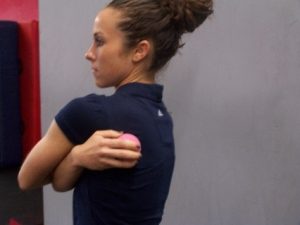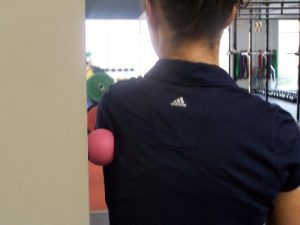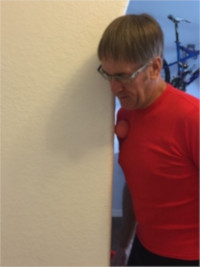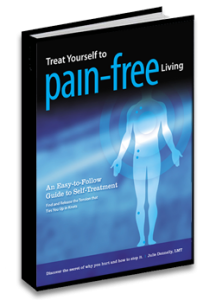Regain a Full Range Of Motion
Author: Julie Donnelly, LMT –The Pain Relief Expert
Editor: Dr. Steve Chaney
May Is A Beautiful Time Of Year
 It’s MAY!! Bring on the flowers that came from the April showers!
It’s MAY!! Bring on the flowers that came from the April showers!
Of course, here in Florida we have flowers all year, so it’s our friends to the north that are enjoying a glorious array of color during this month.
In some ways, life is beginning to slow down for us. With most of the snowbirds gone, driving is easier, the stores are less crowded, and we can park at the beach. The weather is still beautiful so we can still go outside to ride a bike, jog, or play the sports we enjoy. This leads me to talk about a new client who came in and needed frozen shoulder treatment.
What Is A Frozen Shoulder?
 There are 15 muscles that insert into your shoulder, each pulling your arm in a different direction. The term “Frozen Shoulder” is used when a muscle gets so tight that it’s difficult, or impossible to move in the opposite direction. Since there are 15 muscles pulling your shoulder and arm, the possibility of several of them going into spasm and preventing your arm from moving is huge. In fact, it’s pretty amazing that it doesn’t happen more often!
There are 15 muscles that insert into your shoulder, each pulling your arm in a different direction. The term “Frozen Shoulder” is used when a muscle gets so tight that it’s difficult, or impossible to move in the opposite direction. Since there are 15 muscles pulling your shoulder and arm, the possibility of several of them going into spasm and preventing your arm from moving is huge. In fact, it’s pretty amazing that it doesn’t happen more often!
Depending on how many muscles are involved, frozen shoulder can range from a minor inconvenience to the inability to move in any direction at all.
Pain Can Restrict Motion
Recently, a new client, Claire, came into my office with a frozen shoulder. Claire could only lift her arm to a point where it was horizontal to her shoulder, and she couldn’t bring it backward at all. She was in a lot of pain and nothing she tried had worked. Fortunately, I am an expert at teaching people how to treat frozen shoulders and regain a full range of motion.
I first learned how to treat a frozen shoulder when it happened to me in 1994. Every one of the muscles of my left shoulder went into a serious spasm/contraction at the same time. I couldn’t move my elbow more than 2” away from my waistline! The pain was excruciating! I went to every type of practitioner I could imagine: massage (of course), physical therapy, orthopedic physician, chiropractor…in fact I would have gone to a witch doctor if I could have found one. Nothing was working!
Finally, I decided I needed to figure out how to self-treat the muscles that I knew were knotted up and holding my shoulder and arm bound. It took me from September until February to work it out and get my arm back to 100% range-of-motion, but I did it. I was thrilled, and I knew I had to teach this to everyone who has any shoulder pain. If you have my book, Treat Yourself to Pain-Free Living, every shoulder treatment in that book came from my journey through pain. I know they all work!
So, back to my new client. When I saw the movements Claire couldn’t make, I knew that the muscles in the front of her shoulder were pulling her arm forward, and her latissimus dorsi muscle was pulling her arm down. As a result, she couldn’t lift her arm or bring it back.
Frozen Shoulder Treatment
 The next three pictures show you how to treat two of the most common muscles that cause shoulder pain. These are the muscles that were giving Claire so much trouble when she needed frozen shoulder treatment. You’ll be using the Perfect Ball so you can really get to the muscles that are deep in the joint.
The next three pictures show you how to treat two of the most common muscles that cause shoulder pain. These are the muscles that were giving Claire so much trouble when she needed frozen shoulder treatment. You’ll be using the Perfect Ball so you can really get to the muscles that are deep in the joint.
If you are having trouble lifting your arm up, put the Perfect Ball into your opposite hand and following the picture, place it onto your shoulder blade. You need to move it so it’s on the part of the bone that is the back part of your armpit.
 Move your body around until you hit a really tender point. That’s the spasm in the latissimus dorsi that is preventing you from lifting your arm up.
Move your body around until you hit a really tender point. That’s the spasm in the latissimus dorsi that is preventing you from lifting your arm up.
To treat the muscles (pectoralis minor and pectoralis major) that are preventing your arm from going back, you need to lean into the corner of a wall.
 As the picture demonstrates, put the Perfect Ball onto the front of your shoulder and lean into a wall. You can move the ball up and down by bending your knees a bit.
As the picture demonstrates, put the Perfect Ball onto the front of your shoulder and lean into a wall. You can move the ball up and down by bending your knees a bit.
If in either frozen shoulder treatment you want more pressure, move your feet further out from the wall. For less pressure have your feet closer to the wall.
Why stay in pain when it’s so easy to find the muscular source of the problem and eliminate it?
 Treat Yourself to Pain-Free Living . It is filled with over 100 pictures and descriptions proven to show you how to find and self-treat muscle spasms from head to foot!
Treat Yourself to Pain-Free Living . It is filled with over 100 pictures and descriptions proven to show you how to find and self-treat muscle spasms from head to foot!
Join the 1000’s of people worldwide who have discovered that tight muscles were the true source of pains they thought were from arthritis, fibromyalgia, and other serious conditions. You have nothing to lose, and everything to gain by releasing tight muscles.
Treat Yourself to Pain-Free Living is your step-by-step guide to pain relief!
Wishing you well,
Julie Donnelly
These statements have not been evaluated by the Food and Drug Administration. This information is not intended to diagnose, treat, cure or prevent any disease.
About The Author
Julie Donnelly is a Deep Muscle Massage Therapist with 20 years of experience specializing in the treatment of chronic joint pain and sports injuries. She has worked extensively with elite athletes and patients who have been unsuccessful at finding relief through the more conventional therapies.

